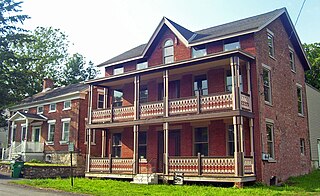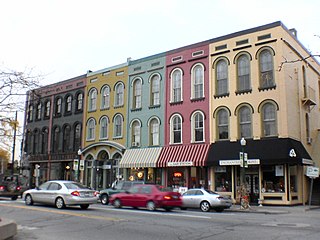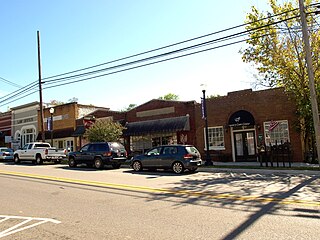
Hurtsboro is a town in Russell County, Alabama, United States. At the 2010 census the population was 553, down from 592 in 2000. It was founded in 1857 as Hurtsville and named for Joel Hurt, Sr.. A railroad spur from Columbus, Georgia was completed the next year. It was incorporated in 1872 and in 1883 the town name was changed to Hurtsboro.

The Marshall Historic District is a National Historic Landmark District that encompasses a significant portion of the central residential and commercial area of Marshall, Michigan. The district is nationally significant for the remarkably unified and well-preserved street plan, architecture, and public infrastructure, one of the largest such concentrations in the nation. It was designated a National Historic Landmark in 1991.
Girard, Alabama was a city in the far north-east corner of Russell County, Alabama across the Chattahoochee River from Columbus, Georgia.

The La Grange Historic District is a national historic district located in La Grange, North Carolina, United States. The district, originally encompassing 225 buildings and 1 structure, includes the historic commercial, residential, and industrial center of La Grange. The buildings include notable examples of Gothic Revival, Queen Anne and Bungalow/American Craftsman styles of architecture and date between the 1850s and the 1940s. Located in the district is the separately listed La Grange Presbyterian Church. Other notable buildings include the Sutton-Kinsey House, Walter Pace House, Sutton-Fields House, Colonel A. C. Davis House (1887), and the Rouse Banking Company Building (1908). The historic district was added to the National Register of Historic Places in May 2000.

Westminster Village–Academy Hill Historic District encompasses the historic first town center of Westminster, Massachusetts, as well as its later early-19th century commercial core. Centered at the junction Main and South Streets with Academy Hill Road, it contains fine examples of Colonial, Federal, and Greek Revival architecture, including the 1839 town hall. The district was listed on the National Register of Historic Places in 1983.

The Main Street Historic District in New Hamburg, New York, United States is located along that street just west of the train station. Six buildings on a single acre are an intact remnant of the hamlet as it was developed in the middle of the 19th century, prior to the Hudson River Railroad's construction, which cut it in half.

The University–Cultural Center MRA is a pair of multiple property submissions to the National Register of Historic Places which were approved on April 29 and May 1, 1986. The structures included are all located in Midtown, near Woodward Avenue and Wayne State University in Detroit, Michigan. The two submissions are designated the University–Cultural Center MRA Phase I, containing five properties, and the University–Cultural Center MRA Phase II, containing three properties.

This is a list of the National Register of Historic Places listings in Mobile, Alabama.

There are 75 properties listed on the National Register of Historic Places in Albany, New York, United States. Six are additionally designated as National Historic Landmarks (NHLs), the most of any city in the state after New York City. Another 14 are historic districts, for which 20 of the listings are also contributing properties. Two properties, both buildings, that had been listed in the past but have since been demolished have been delisted; one building that is also no longer extant remains listed.

The Conyers Residential Historic District is an irregularly-shaped historic district in Conyers, Georgia, the only city in Rockdale County, Georgia, located 24 miles east of Atlanta. The district's development dates from the 1840s.

Reverie is a historic Greek Revival mansion built circa 1858 in Marion, Perry County, Alabama. It now serves as a residence and also historic house museum. It is listed on the National Register of Historic Places as a contributing property to the West Marion Historic District and was recorded by the Historic American Buildings Survey. It is featured in Ralph Hammond's Antebellum Mansions of Alabama, Gregory Hatcher's Reverie Mansion and Gardens, and Jennifer Hale's Historic Plantations of Alabama's Black Belt.

The Barre Downtown Historic District encompasses the historic commercial and civic heart of the city of Barre, Vermont. Extending along Main Street from City Park to Depot Square, this area was developed quite rapidly in the 1880s and 1890s, when the area experienced rapid growth due to the expansion of the nearby granite quarries. It was listed on the National Register of Historic Places in 1979.

The Ypsilanti Historic District is a historic district located along several blocks on each side of the Huron River in the center of Ypsilanti, Michigan. The original portion of the district was designated a Michigan State Historic Site in 1973 and listed on the National Register of Historic Places in 1978; additions to the district were nationally listed in 1989.

The Attalla Downtown Historic District is a historic district in Attalla, Alabama. The city was founded in 1870 along the Alabama and Chattanooga Railroad. It quickly developed into a major iron ore export hub. After fires in 1887 and 1891, most of the frame buildings downtown were replaced with brick structures. The oldest buildings in the district, which date from the 1880s and 1890s, are built in Folk Victorian styles, with corbelled cornices and other decorative elements. Later buildings are in more plain Commercial Brick styles, while others were built in more academic styles, including the Art Moderne Etowah Theatre and the Colonial Revival Post Office building. The district was listed on the Alabama Register of Landmarks and Heritage in 2011 and the National Register of Historic Places in 2013.

The Vermont Historic District is a national historic district located in downtown Vermont, Illinois. The district encompasses the commercial core of the village around Vermont's public square and along Main Street to the north; it includes 30 buildings, 23 of which are contributing buildings. The buildings in downtown Vermont functioned as the village's shopping and entertainment district as well as the home of fraternal halls such as the Vermont Masonic Hall. While commercial development in Vermont began in the 1840s, the oldest surviving building in the district dates to circa 1858; the building has a Greek Revival design, as was common among Vermont's early commercial buildings. A major building boom took place in the late 1860s and 1870s due to the village's rising population and railroad service; most buildings from this period have Italianate designs. Another building boom in the late 1880s and early 1890s brought several new Late Victorian buildings to the district. After the turn of the century, a number of Commercial style buildings were constructed as well.

The Poultney Main Street Historic District encompasses the commercial and residential historic core of the village of Poultney, Vermont. Centered on Main Street and East Main Street, between College Avenue and St. Raphael's Catholic Church, the district includes a diversity of architectural styles, as well as civic, religious, and commercial functions spanning a period of more than 100 years. The district was listed on the National Register of Historic Places in 1988.

The Joel Hurt House is a historic house in Hurtsboro, Alabama, U.S.. It was built in 1857-1858 for Joel Hurt, his wife, Lucy Apperson Long Hurt, and three sons. During the American Civil War of 1861–1865, the three sons served in the Confederate States Army, and one of them was killed in combat. After the war, Lucy's sister and her husband, Edward Norphlet Brown, who also served as the first mayor of Hurtsboro, lived in the house. In 1900, it was acquired by his son-in-law, Dr. Walter B. Hendrick, who lived there with his wife Margaret until his death in 1941; she went on to live in the house until her death in 1968. It was inherited by their daughter Kate, who lived there until her death in 1997. It has been listed on the National Register of Historic Places since August 11, 2005.

The Springville Historic District is a historic district in Springville, Alabama. The area around the "Big Spring" remained sparsely populated from 1814, when the land was ceded to the United States by the Creek Nation, until after the Civil War. A post office was established in 1834, and a sawmill was founded in 1861, but development did not begin in earnest until the coming of the Alabama and Chattanooga Railroad in 1870. Now connected to Atlanta and Columbus, Mississippi, business and industry began to center in Springville, and the town was a center for moving ore from the surrounding hills to industrial centers in Birmingham and Tuscaloosa.
Woodlawn, Alabama is a community in Jefferson County, Alabama, which is now a neighborhood within the city of Birmingham, Alabama. It grew as an independent community, and became the City of Woodlawn, and built a substantial City Hall building in 1908, but was annexed by Birmingham in 1910. The community area experienced a surge of growth after it was annexed.
The Brownville–Summerville Historic District is a historic district in Phenix City, Alabama. The district covers approximately 87 acres (35 ha) of mostly residential area to the west and northwest of the city's commercial core. The earliest houses in the district date from circa 1870, and are either Greek Revival or Saddlebag cottages. Beginning in the 1880s, many Victorian cottages were built by employees at the town's cotton mills and iron works. In the 1920s and 1930s, bungalows continued to be built. Several commercial buildings, most brick and dating from the 1920s, are scattered throughout the district.



















